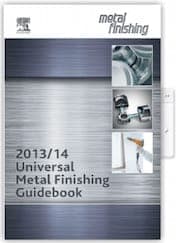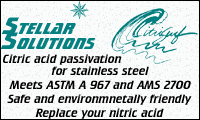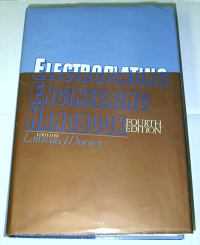
Thread 44/76
Stripping copper plating from stainless steel
Quickstart:
Please note that this discussion is about stripping copper from STAINLESS steel. Some of the proposed stripping solutions mentioned here, most notably nitric acid, react disastrously with plain steel.
For stripping copper from plain steel, please see threads 33078 and 57539.
Q. WE MANUFACTURE VERY PRECISE AIRCRAFT ENGINE (JET) SEALS FROM 17-4PH STAINLESS STEEL. THEY ARE COPPER PLATED 0.4 MILS MIN.IN SELECTED AREAS TO PREVENT NITRIDING. AFTER NITRIDING THE COPPER IS STRIPPED IN A NON-ELECTRIC (IMMERSION) SODIUM CYANIDE SOLUTION.
WE ARE LOOKING FOR A NON-TOXIC, NON-ETCH REPLACEMENT.
DOES ANYONE HAVE A SUGGESTIONS?
THANKS,
LLOYD
GENERAL MACHINERY & MFG. CO. - chicago, Illinois, USA
2000
publicly reply to Lloyd steirer
A. Lloyd - A great way to strip off the copper plating from SS is to use a peroxide-based stripper. No electricity is required and the process can take as little as 2-5 minutes. Good Luck.
Dan Brewerchemical process supplier - Gurnee, Illinois
publicly reply to Dan Brewer
A. I do not think you can find a really non-toxic alternative, but using cyanide-base solution is not required. You can use oxidizing acid like a standard passivating solution (any one recommended for the PH stainless steels), or simply a 50% nitric acid (room temperature), chromic acid, etc. Make sure the parts are well degreased prior to treatment with oxidizing acids.
Regards, Max
Max Steincaptive metal finisher - Montreal, Québec, Canada
publicly reply to Max Stein
To: Lloyd Steirer:
adv.
We manufacture a copper stripper that is very effective in stripping copper from steel and stainless steel. It was developed in response to a request from Boeing Aircraft and has been approved for use by Boeing (spec #BAC5771. It DOES NOT etch stainless steel, has a pH of 10.2 - 10.8 containing no acids nor cyanides. It is a one-component powder that is mixed with tap water and used at room temperature. This is a low-voltage electrical stripper with an extremely long life. Phone, fax or e-mail me and I will forward literature and lab sample for your in-house testing. Regards, Gayle
Metalx Specialty Products / Ronatec
Fallbrook, California

publicly reply to Gayle Coffey
Multiple threads merged: please forgive chronology errors and repetition 🙂
De-plating Copper
Q. I'm looking for a way to "de-plate" copper from a stainless steel cathode roller. Any help out there?
sometimes on
AbeBooks or Amazon
(affil links)

free pdf is currently available from academia.edu
- Marlborough, New Hampshire
2001
publicly reply to John Wall
A. Copper is readily attacked by alkalies; hence, a hot sodium or potassium hydroxide solution will remove the copper quite easily, especially in conjunction with ultrasonics. The high pH will have little or no effect on most stainless.
Waste disposal: The copper hydroxide will be the bluish sediment in the stripping solution after the reaction is over. As long as the pH is high, the stripping solution should will not have a lot of residual copper. After the copper hydroxide settles out, decant the clear liquid off of the sediment--if the copper concentration is low enough, you can dilute it and dispose of the liquid. You can either dry the remains and properly dispose of the copper hydroxide (toxic), or you can treat the remaining precipitate as is; the copper hydroxide will dissolve in acids--you can adjust the pH of the remaining (solution + precipitate) with HCl to make copper nitrate. Then, you adjust the pH back to neutral with baking soda [in bulk on eBay or Amazon [affil links] or whatever you have lying around. The Copper nitrate can be disposed of via your normal hazmat provider. You can go one step further & roast it in air at 250 °C or so to make copper oxide, but that is just more mess and hazmat to worry about.
Was this too much info?
Dale Woika- Bellefonte, Pennsylvania, US
publicly reply to Dale Woika
⇦ Tip: Readers want to learn from your situation,
so some readers just skip abstract questions.
Q. SOME PEOPLE ON THIS SITE POSTED THAT YOU CAN USE SODIUM HYDROXIDE OR POTASSIUM HYDROXIDE IN A SOLUTION TO REMOVE COPPER FROM STEEL. CAN ANYONE TELL ME HOW MANY POUNDS OF FLAKES OR PEARLS IT WOULD TAKE TO MAKE UP ABOUT 3 GALLONS OF THE SOLUTION. THANKS BILL
BILL SNYDERHOBBYIST PLATER - PENSACOLA, Florida, USA
2007
publicly reply to BILL SNYDER
A. Hi Bill,
Dale said "stainless" steel, which is not plain steel. But it has a good chance of working to some degree on steel depending on your situation, the thickness of the plating, and what you consider satisfactory stripping. As Guillermo notes below, some staining may occur, indicating some degree of attack on the steel.
A couple of pounds per gallon is probably appropriate, but whenever possible you should try to do beaker tests of any proposed solutions before mixing up full batches of anything based on book knowledge or someone else's situation :-)
But please only work with stuff you are trained in and familiar with. Misreading as you did and putting plain steel in nitric acid would have been catastrophic.
Best of Luck,

Ted Mooney, P.E.
Striving to live Aloha
finishing.com - Pine Beach, New Jersey
publicly reply to Ted Mooney
A. Nitric acid would remove the copper a lot faster and at room temp. Down side being nitrous oxides you need a fume cupboard or extraction.

Martin Trigg-Hogarth
surface treatment shop - Stroud, Glos, England
2001
publicly reply to Martin Trigg-Hogarth
A. John -
Another way of stripping the copper is to use a peroxide/sulfuric acid blend. The solution runs at just above room temp and doesn't generate the fumes of some other methods. It also creates copper sulphate as a precipitate and the peroxide is easy to waste treat.
Dan Brewerchemical process supplier - Gurnee, Illinois
publicly reply to Dan Brewer
Multiple threads merged: please forgive chronology errors and repetition 🙂
Removing Copper Plating from Stainless Steel
Q. We have been painting stainless steel hinges for some time. One of our customers asked us to also pretreat their hinges by passivating. We took them up on it and have been doing so for a couple weeks using copper sulphate
⇦ on
eBay or
Amazon [affil links] for a drop test to confirm the stainless steel is passive.
We have had a couple failures which results in the copper sulphate plating out copper on the part. We have been able to remove most of the copper by wiping, but this is not 100%. We would like to strip the copper without damaging the stainless steel; we process 302 and 304 stainless steel.
Is there a way to do this?
Plating Shop Employee - Madison Heights, Michigan
2007
publicly reply to Erik Kafarski
|
A. Very few things are easier than removing copper from stainless steel; diluted nitric acid will easily do the trick, and steel will only be "more" passivated. Bo König- Odense, Denmark publicly reply to Bo König A. Nitric acid solutions work well. Ken Vlach [deceased]- Goleta, California Rest in peace, Ken. Thank you for your hard work which the finishing world, and we at finishing.com, continue to benefit from. publicly reply to Ken Vlach [deceased] A. Persulphate will do the trick.  Ray Kremer Stellar Solutions, Inc. McHenry, Illinois  publicly reply to Ray Kremer |
A. All the above answers are satisfactory because you are talking about hinges. But for critical and delicate surfaces, if the acid copper stains, it means that some material from the surface was lost and the surface is immediately damaged from the moment it is stained.
Guillermo MarrufoMonterrey, NL, Mexico
publicly reply to Guillermo Marrufo
Q, A, or Comment on THIS thread -or- Start a NEW Thread
